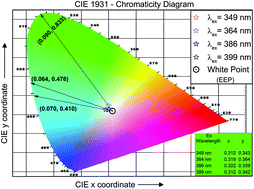Emerging cool white light emission from Dy3+ doped single phase alkaline earth niobate phosphors for indoor lighting applications
Abstract
Single-phase cool white-light emitting BaNb2O6:Dy3+ phosphors have been synthesized via a conventional solid-state reaction method and characterized using X-ray diffraction (XRD), scanning electron microscopy (SEM) observations and spectrofluorophotometric measurements. XRD and Rietveld structural refinement studies confirm that all the samples exhibit pure orthorhombic structure [space group – C2221(20)]. SEM observations reveal the dense particle packaging with irregular morphology in a micron range. The as-prepared phosphors exhibit blue (482 nm) and yellow (574 nm) emissions under 349, 364, 386 and 399 nm excitations corresponding to 4F9/2 → 6HJ (J = 15/2, 13/2) transitions of Dy3+ ions. The energy transfer mechanism between Dy3+ ions has been studied in detail and the luminescence decay lifetime for the 4F9/2 level was found to be around 146.07 μs for the optimized phosphor composition. The calculated Commission Internationale de L'Eclairage (CIE) chromaticity coordinates for the optimized phosphor are (x = 0.322, y = 0.339), which are close to the National Television Standard Committee (NTSC) (x = 0.310, y = 0.316) coordinates. The values of CIE chromaticity coordinates and correlated color temperature (CCT) of 5907 K endorse cool white-light emission from the phosphor. The study reveals that BaNb2O6:Dy3+ phosphor could be a potential candidate for near ultra-violet (NUV) excited white-LED applications.



 Please wait while we load your content...
Please wait while we load your content...